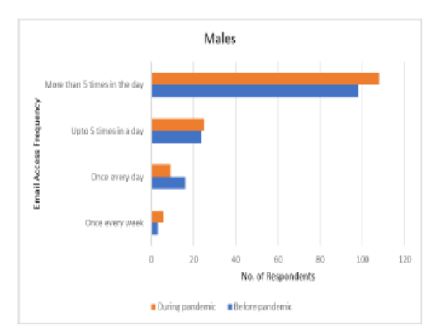


Indian Journal of Science and Technology
Year: 2023, Volume: 16, Issue: 44, Pages: 3987-3994
Original Article
Yogesh S Kulkarni1*, Yogesh Naik2
1CTO, Ellicium Solutions, India
2Founder, COGITARI®, India
*Corresponding Author
Email: [email protected]
Received Date:26 March 2023, Accepted Date:20 October 2023, Published Date:20 November 2023
Objectives: To analyse the impact of the Covid-19 pandemic on employees working in the Indian IT sector in terms of email access frequency. Methods: To achieve our result, we gathered data from 189 people working in the IT sector in the month of March 2023 and analysed it. Out of these, 144 were males (76%) and 45 were females (24%). In terms of the work location, 112 people (59%) were from metros and the balance 77 (41%) were from non-metros. We also tested a few hypotheses related to it. Data for the study was obtained using primary study by an online questionnaire created using Google forms. It was shared with different people from the Indian IT sector across the major cities like Bangalore, Hyderabad, Pune, Mumbai, on a convenience sampling basis and using electronic media like emails and social media groups. The respondents had to perceive the scenario before the pandemic and give their responses accordingly. For the data analysis, Gender, Location and Experience were the independent variables, and Email Access Frequency and Email number were the dependent variables. Analysis was done using SPSS and MS Excel using charts. Analysis of Variance (ANOVA) was used to test the hypotheses for differences in email usage before and during the pandemic. Findings: Our research shows that there was a significant change in email access frequency of employees before the Covid-19 pandemic and during it. The frequency of accessing emails has increased by 16.5% overall i.e., they have been accessing emails more frequently during the pandemic than before. The increase is more for females (52.9%) than males (10.2%) and for both, metro as well as non-metro work locations. While similar studies have been conducted in other geographies worldwide, the reported increase in emails in those studies has been very diverse i.e., from 5% to 95%. Also, other studies were conducted in their specific regions with a focus on analyzing the impact on the wellness of people. Novelty: As per our knowledge, this kind of study focused on email access frequency and usage, is new in the context of India for the IT sector.
Keywords: Email Usage, Information Technology, Covid19, Pandemic, Work Pattern
© 2023 Kulkarni & Naik. This is an open-access article distributed under the terms of the Creative Commons Attribution License, which permits unrestricted use, distribution, and reproduction in any medium, provided the original author and source are credited. Published By Indian Society for Education and Environment (iSee)
Subscribe now for latest articles and news.